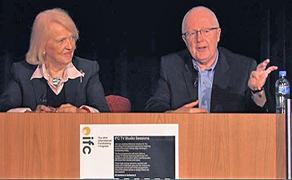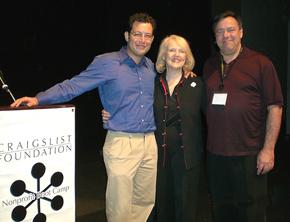Kay Sprinkel Grace: America’s doyenne of board excellence and mission development.
- Written by
- Christiana Stergiou
- Added
- March 25, 2010

Kay Sprinkel Grace is a dreamer, a big picture fundraiser. This, along with her special way with words, has made her one of the great fundraisers of our time.
Kay says, ‘A lot of people get bogged down in the minutia because, every day, they’re trying to make ends meet, or trying to exceed their goals. I can come in and say, take a deep breath, let’s imagine we’re at 30,000 feet looking down on this. It looks a whole lot different from 30,000 feet.’
Kay’s own journey has been one of transformation and, in turn, she has transformed many hundreds of organisations and individuals with which she has worked. Whether she is speaking at conferences and workshops around the world, or working with boards, volunteers and staff as a consultant, Kay is hot property when it comes to the fundraising.
 View original image
View original image
It all started with a career in journalism. That, in turn, led to career number two, in education. And finally, in her late thirties, Kay joined the nonprofit sector and many have since come to embrace, as their own, her unique approach to giving.
As with many of us fundraisers, Kay’s path into fundraising and philanthropy was accidental. As a volunteer for Stanford, her university, she had represented the organisation in their development efforts around the country. When her career in education came to an abrupt end, as a result of redundancies in her school district, a friend suggested she take on the role of development director at Stanford University.
 Kay Grace in her own words
Kay Grace in her own words
Most members of the organisation’s board knew her well, and, even though she had no professional fundraising experience, were confident that she was the right person for the role. Little did they know they were helping to shape the career of one of the great fundraisers of our time.
Within a few years, Kay was teaching at the famous Fundraising School, now a part of Indiana University’s Center on Philanthropy in Indianapolis, but then an independent organisation, under the tutelage of another great fundraiser, Henry A (Hank) Rosso. Although Kay openly admits that she was both teaching andlearning.
‘I remember the first time I taught in front of Hank,’ she says. ‘I’ve never been so terrified in my life, I wanted him to just leave the room. I remember staying up half the night, I was so nervous about teaching in front of him, or with him, but I never dreamed he would sit at the back of the room the entire time. Somehow I got through it and at the end he had this critique that was three pages long. I thought that I would never be able to do it. But it all worked after a while.’
Since then, Kay has gone on to become a highly sought after independent consultant and author of six books on fundraising and philanthropy.
In addition, Kay is a trend spotter and, with a strong undergraduate and early professional background in journalism, she has developed and promoted a now universally accepted fundraising vocabulary. ‘Donor-investor’ is a phrase that Kay coined in her first book, Beyond Fundraising, to convey the move from away from charity towards involvement. Kay says, ‘You know, I hear that everywhere now. Nothing could give me greater pleasure.’
However, back in 1997, when her book was first published, it created some controversy. The title alone, Beyond Fundraising: new strategies for nonprofit innovation and investment, resulted in Kay receiving phone calls from her colleagues saying, ‘How can you put the word investment on the cover of a fundraising book?’
Another of Kay’s aphorism’s from 20 years ago, ‘putting away the tin cup’ was also revolutionary at the time and continues to inspire fundraisers today. She says, ‘Even though fundraisers knew that fundraising wasn’t about begging, they didn’t know how to say it.’
Regardless of the critics, the social investment movement gained momentum and is still changing rapidly. Some nonprofits and fundraisers seem to be playing a reluctant game of catch-up when facing the many new challenges. As a sector, we now have new challenges to confront. Kay says:
The dreams of donors are driving philanthropy in two ways. One is that the very wealthy donors, people like Bill Gates and George Soros and Ted Turner, have these colossal dreams and they just create foundations. They basically do it without engaging with our sector, except when they can’t provide those services themselves. And this says something a little critical of our sector – it is possible, and I believe it’s true, that we are viewed as not very nimble. That we seem to be bogged down, that we don’t often move as quickly on ideas and the dreams of donors as they would like to see it happen.
‘The other way is that we now have more of what I call citizen philanthropists, they’re the ones with the computer and the rolladex. They find a cause that they care about and they are increasingly doing the viral marketing on behalf of these organisations. An example is www.kiva.org and the young man who raised $72,000 in no time at all from his equally as young and poor friends, because he was possessed by these dreams of these microeconomic loans.
‘In the middle, we have those people, some very young people, who are also starting their own organisations. And if there is one thing that I am speaking out about at the moment, it is starting a new nonprofit. Do not clutter the world with another nonprofit. We have 1.5 million nonprofits in the US and possibly one third will either go out of business or merge.’
A trend that really worries Kay is that as we became more ‘professional’ we felt that we needed volunteers less in our major gift fundraising. She explains, ‘I think this is a huge mistake, because the very biggest thing we know about donors is that they give when they see their peers involved. So when a donor is called on by someone in the community, someone he or she knows and respects and realises is giving up valuable time, she is more likely to give at a higher level than when approached by a staff member.’
Now that many nonprofits in the USA are struggling in the economic downturn, even making redundancies, Kay finds it ironic that they no longer have a team of major gift fundraisers. Volunteers will always have a role, even in increasingly professional organisations.
According to Kay technology has revolutionised fundraising. ‘It is the greatest thing that has ever happened, but we need to use it more effectively. It is one of the best assets we have for good stewardship of our donors’ gifts. It greatly enhances our ability to communicate with our donors, to say thank you, to tell stories, to give good news, to give that extra bit of information.’
Kay continues to meet the challenges that the future brings through her transformational work with nonprofits and her influential presentations at conferences and workshops around the world. As well as Beyond Fundraising, Kay has written five other books. Her Ultimate Board Members handbook, at just 112 pages has sold over 22,000 copies. Her sixth book about the effective engagement of board and non-board volunteers will be published in August 2009.
The way Kay measures her effectiveness is by the letters and emails she gets. She doesn’t have a trophy wall, just a collection of communications that say, ‘Your book changed my thinking; your seminar changed my direction; you have changed our future.’ When asked how she would like to be remembered, she doesn’t hesitate,
‘That I helped change the conversation, the understanding, and the future of philanthropy.’
That’s no small task. We at SOFII think you’ve achieved it, for the good of us all.
You can find out more about Kay at her website.
 Christiana Stergiou is an accomplished fundraiser, has her own fundraising consultancy, Scribbly Bark, and was SOFII’s resident writer and editor in 2010. To get in touch with her, please email her.
Christiana Stergiou is an accomplished fundraiser, has her own fundraising consultancy, Scribbly Bark, and was SOFII’s resident writer and editor in 2010. To get in touch with her, please email her.
ADD TO KAY’S PROFILE: If you have any interesting and instructive anecdotes, quotes, observations or Kay Grace -isms that you feel will add to this feature, please send them in to Carolina and help make SOFII better.
Reader’s comments:
Hi Carolina,
I would like to pay tribute to the impact Kay Sprinkel Grace has had on so many fundraisers, board members and donors beyond her own country. Kay has been an intermittent and much revered visitor to fundraising conferences here in Australia and has truly left her unique stamp – whether lecturing, mentoring or dancing!Long before ‘donor-centred, donor-based and relationship’ fundraising became buzzwords, this was the ethos Kay was modelling and teaching.You asked about memorable phrases and I have always been inspired by Kay’s characterisation of fundraisers as ‘pragmatic dreamers’ because this marriage of big visions with the ability to make them happen really sums up good fundraising to me.The other ‘Kay message’ that has always guided me is that fundraising is about people’s values. If we understand and make it easy and worthwhile for people to act on those values, we really are doing what Kay’s mentor Hank Rosso always suggested we do: teach the joy of giving.I am so pleased that SOFII has profiled this amazing person whose intellect and charisma has transformed many fundraisers and their missions across the globe.
- Dr Wendy Scaife, Senior Research Fellow, Faculty of Business, Australian Centre for Philanthropy and Nonprofit Studies at Queensland University of Technology.

















